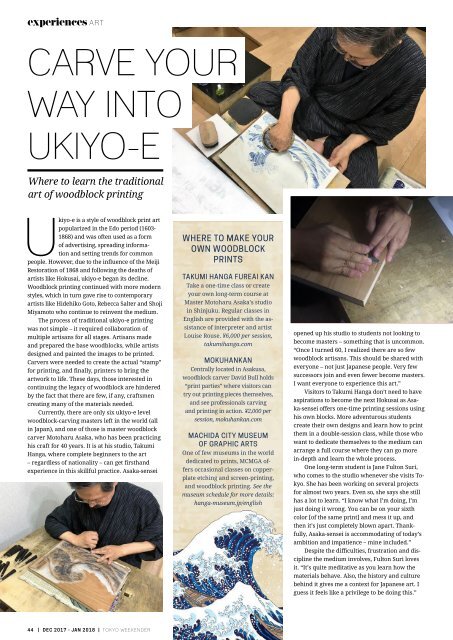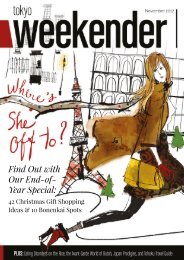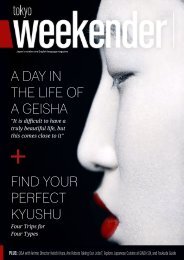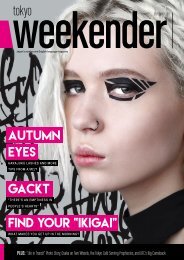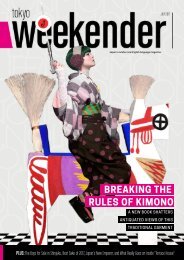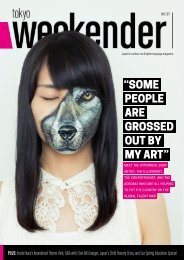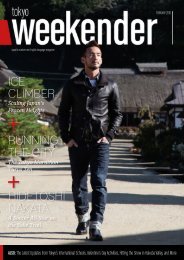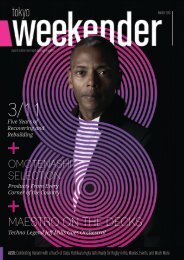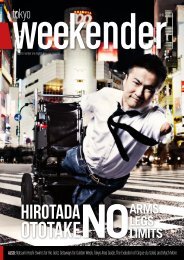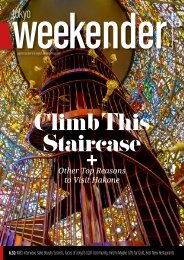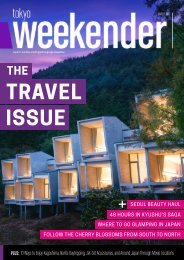Tokyo Weekender - December 2017 - January 2018
You also want an ePaper? Increase the reach of your titles
YUMPU automatically turns print PDFs into web optimized ePapers that Google loves.
experiences ART<br />
CARVE YOUR<br />
WAY INTO<br />
UKIYO-E<br />
Where to learn the traditional<br />
art of woodblock printing<br />
Ukiyo-e is a style of woodblock print art<br />
popularized in the Edo period (1603-<br />
1868) and was often used as a form<br />
of advertising, spreading information<br />
and setting trends for common<br />
people. However, due to the influence of the Meiji<br />
Restoration of 1868 and following the deaths of<br />
artists like Hokusai, ukiyo-e began its decline.<br />
Woodblock printing continued with more modern<br />
styles, which in turn gave rise to contemporary<br />
artists like Hidehiko Goto, Rebecca Salter and Shoji<br />
Miyamoto who continue to reinvent the medium.<br />
The process of traditional ukiyo-e printing<br />
was not simple – it required collaboration of<br />
multiple artisans for all stages. Artisans made<br />
and prepared the base woodblocks, while artists<br />
designed and painted the images to be printed.<br />
Carvers were needed to create the actual “stamp”<br />
for printing, and finally, printers to bring the<br />
artwork to life. These days, those interested in<br />
continuing the legacy of woodblock are hindered<br />
by the fact that there are few, if any, craftsmen<br />
creating many of the materials needed.<br />
Currently, there are only six ukiyo-e level<br />
woodblock-carving masters left in the world (all<br />
in Japan), and one of those is master woodblock<br />
carver Motoharu Asaka, who has been practicing<br />
his craft for 40 years. It is at his studio, Takumi<br />
Hanga, where complete beginners to the art<br />
– regardless of nationality – can get firsthand<br />
experience in this skillful practice. Asaka-sensei<br />
WHERE TO MAKE YOUR<br />
OWN WOODBLOCK<br />
PRINTS<br />
TAKUMI HANGA FUREAI KAN<br />
Take a one-time class or create<br />
your own long-term course at<br />
Master Motoharu Asaka’s studio<br />
in Shinjuku. Regular classes in<br />
English are provided with the assistance<br />
of interpreter and artist<br />
Louise Rouse. ¥6,000 per session,<br />
takumihanga.com<br />
MOKUHANKAN<br />
Centrally located in Asakusa,<br />
woodblock carver David Bull holds<br />
“print parties” where visitors can<br />
try out printing pieces themselves,<br />
and see professionals carving<br />
and printing in action. ¥2,000 per<br />
session, mokuhankan.com<br />
MACHIDA CITY MUSEUM<br />
OF GRAPHIC ARTS<br />
One of few museums in the world<br />
dedicated to prints, MCMGA offers<br />
occasional classes on copperplate<br />
etching and screen-printing,<br />
and woodblock printing. See the<br />
museum schedule for more details:<br />
hanga-museum.jp/english<br />
opened up his studio to students not looking to<br />
become masters – something that is uncommon.<br />
“Once I turned 60, I realized there are so few<br />
woodblock artisans. This should be shared with<br />
everyone – not just Japanese people. Very few<br />
successors join and even fewer become masters.<br />
I want everyone to experience this art.”<br />
Visitors to Takumi Hanga don’t need to have<br />
aspirations to become the next Hokusai as Asaka-sensei<br />
offers one-time printing sessions using<br />
his own blocks. More adventurous students<br />
create their own designs and learn how to print<br />
them in a double-session class, while those who<br />
want to dedicate themselves to the medium can<br />
arrange a full course where they can go more<br />
in-depth and learn the whole process.<br />
One long-term student is Jane Fulton Suri,<br />
who comes to the studio whenever she visits <strong>Tokyo</strong>.<br />
She has been working on several projects<br />
for almost two years. Even so, she says she still<br />
has a lot to learn. “I know what I’m doing, I’m<br />
just doing it wrong. You can be on your sixth<br />
color [of the same print] and mess it up, and<br />
then it’s just completely blown apart. Thankfully,<br />
Asaka-sensei is accommodating of today’s<br />
ambition and impatience – mine included.”<br />
Despite the difficulties, frustration and discipline<br />
the medium involves, Fulton Suri loves<br />
it. “It’s quite meditative as you learn how the<br />
materials behave. Also, the history and culture<br />
behind it gives me a context for Japanese art. I<br />
guess it feels like a privilege to be doing this.”<br />
44 | DEC <strong>2017</strong> - JAN <strong>2018</strong> | TOKYO WEEKENDER


